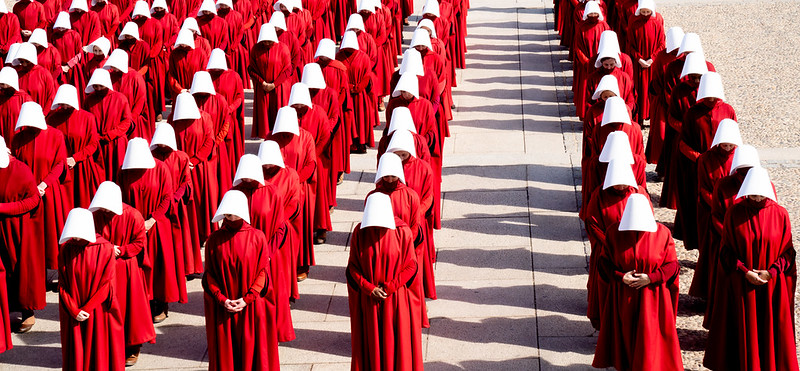18.3 Social Change
William Little and Ron McGivern
The dynamics of collective behaviour and social movements are just two of the forces driving social change, which is the change in society created through social movements as well as external factors like environmental shifts or technological innovations. Essentially, any disruptive shift in the status quo, be it intentional or random, human-caused or natural, can lead to social change.
In other chapters of the textbook, various causes of social change have been discussed. Karl Marx explained social change as a product of struggles and inequalities over the control and distribution of resources in societies. Emile Durkheim described the increasing specialization and differentiation of social institutions as a product of the increased “moral density” of populations (i.e.,increased contact and interaction among people) and corresponding competition for scarce resources. Max Weber emphasized the introduction of rationalization and technology as processes of organizational efficiency that had profound effects on all areas of life. Other chapters will discuss the effect of population dynamics and ecological processes on social change.
This chapter ends by focusing on the impact of technological innovation on social change.
What is Technology?
It is easy to look at the latest sleek tiny Apple product and think that technology is only recently a part of our world. But from the steam engine to the most cutting-edge robotic surgery tools, technology describes the application of science to address the problems of daily life. Students might look back at the enormous and clunky computers of the 1970s that had about as much storage as an iPod Shuffle and roll their eyes in disbelief. But chances are 30 years from now today’s skinny laptops and sleek Bluetooth speakers will look just as archaic.
Technology is therefore not merely a product of the modern era. For example, fire, stone tools and aquaculture were important forms of technology developed during the Stone Age. Archaeological evidence shows early humans innovating on their stone tools from the earliest sharpened stones to Levallois stone knives to geometric microliths (Clark, 1969). Just as the availability of digital technology shapes how people live today, the creation of stone tools changed how premodern humans lived, adapted to changes in the environment and climate, and how well they ate.

From the first calculator, invented in 2400 BCE in Babylon in the form of an abacus, to the predecessor of the modern computer, created in 1882 by Charles Babbage, technological innovations often follow lines of development which make advancements on previous iterations. These define technological lineages that have profound effects on human society.
For example, White (1962) describes the adoption of the stirrup in early medieval Europe from China as an event that revolutionized warfare and created the conditions for the emergence of the feudal system (see Chapter 4. Society and Modern Life). During the period of the Roman Empire and expansion to Northern Europe, wars had been fought mainly on foot. The stirrup allowed warfare to be conducted effectively on horseback, enabling tactical mobility and speed, and creating a lineage of rapid attack military technology from the cavalry of the middle ages to the motorized tank troupes of the 20th and 21st century.
This development had a profound impact on the formation of feudal society. White notes that, as effective as the mounted fighter with stirrups was as an instrument of war, these fighters were also extremely expensive, both in terms of the armour and large horses required, as well as the amount of training needed to master the skills of mounted warfare. To maintain a mounted army, the aristocracy was obliged to distribute land in compensation. The technological innovation of the stirrup thus contributed to the development of the feudal property system whereby vassals or knights were granted manors and estates by the aristocracy in return for their military service.

Marshall McLuhan (1964) defined technologies as extensions of the body. They amplify or accelerate functions originally performed by the human organism unaided, ultimately taking over and transforming these functions. The wheel is an extension of the foot, amplifying its capacity for transport; clothing is an extension of the skin, amplifying its capacity to regulate body heat and protect from abrasions; the electronic media are extensions of the human nervous system, amplifying its sensorium and capacity to feel to the entire world. For McLuhan, a human being in the electronic age is quite literally “an organism that now wears its brain outside its skull and its nerves outside its hide” (Mcluhan, 1964).
As a result, McLuhan argued that the users of technology are “perpetually modified by it” (McLuhan, 1964). Humans shape tools and technology, which thereafter shape humans and human social life. As McLuhan put it,
This is merely to say that the personal and social consequences of any medium—that is, of any extension of ourselves—result from the new scale that is introduced into our affairs by each extension of ourselves, or by any new technology (McLuhan, 1964).
Today all aspects of life are influenced by technology. In agriculture, the introduction of machines that can till, thresh, plant, and harvest greatly reduced the need for manual labour, which in turn meant there were fewer rural jobs, which led to the urbanization of society, as well as lowered birthrates because there was less need for large families to work the farms. In the criminal justice system, the ability to ascertain innocence through DNA testing has saved the lives of people on death row but has also opened the prospect of a new biological criminology in which prospective criminals could be identified by genetic predispositions or neural brain scans and confined in advance of committing any crime. The examples are endless: technology plays a role in absolutely every aspect of social life.
Categorizing Technology
There is no one way of dividing technology into categories. Whereas once it might have been simple to classify innovations such as machine-based or drug-based or the like, the interconnected strands of technological development mean that advancement in one area might be replicated in dozens of others. For simplicity’s sake, one can look at how the U.S. Patent Office, which receives patent applications for nearly all major innovations worldwide, addresses patents. This regulatory body patents three types of innovation. Utility patents are the first type. These are granted for the invention or discovery of any new and useful process, product, or machine, or for a significant improvement to existing technologies. The second type of patent is a design patent. Commonly conferred in architecture and industrial design, this means someone has invented a new and original design for a manufactured product. Plant patents, the final type, recognize the discovery of new plant types that can be asexually reproduced. While genetically modified food is the hot-button issue within this category, farmers have long been creating new hybrids and patenting them. A more modern example might be food giant Monsanto, which patents corn with built-in pesticide (U.S. Patent and Trademark Office, 2011).
Such evolving patents have created new forms of social organization and disorganization. Efforts by Monsanto to protect its patents have led to serious concerns about who owns the food production system, and who can afford to participate globally in this new agrarian world. This issue was brought to a head in a landmark Canadian court case between Monsanto and Saskatchewan farmer Percy Schmeiser. Schmeiser found Monsanto’s genetically modified “Roundup Ready” canola growing on his farm. He saved the seed and grew his own crop, but Monsanto tried to charge him licensing fees because of their patent. Dubbed a true tale of David versus Goliath, both sides are claiming victory (Mercola, 2011; Monsanto, N.d.). What is important to note is that through the courts, Monsanto established its right to the ownership of its genetically modified seeds even after multiple plantings. Each generation of seeds harvested still belonged to Monsanto. For millions of farmers globally, such a new market model for seeds represents huge costs and dependence on a new and evolving corporate seed supply system.
Anderson and Tushman (1990) suggest an evolutionary model of technological change, in which a breakthrough in one form of technology leads to a number of variations. Once those are assessed, a prototype emerges, and then a period of slight adjustments to the technology, interrupted by a breakthrough. For example, floppy disks were improved and upgraded, then replaced by zip disks, which were in turn improved to the limits of the technology and were then replaced by flash drives. This is essentially a generational model for categorizing technology, in which first-generation technology is a relatively unsophisticated jumping-off point leading to an improved second generation, and so on.
Technology and Social Change
Modernization describes the processes that increase the amount of specialization and differentiation of structure in societies resulting in the move from an undeveloped society to developed, technologically driven society (Irwin, 1975). By this definition, the level of modernity within a society is judged by the sophistication of its technology, particularly as it relates to infrastructure, industry, and the like.
Some would say that improving technology has made lives easier. Imagine what the day would be like without the internet, the automobile, or electricity. In The World Is Flat, Thomas Friedman (2005) argues that technology is a driving force behind globalization, while the other forces of social change (social institutions, population, environment) play comparatively minor roles. He suggests that sociologists can view globalization as occurring in three distinct periods. First, globalization was driven by military expansion, powered by horsepower and windpower. The countries best able to take advantage of these power sources expanded the most, exerting control over the politics of the globe from the late 15th century to around the year 1800. The second shorter period, from approximately 1800 CE to 2000 CE, consisted of a globalizing economy. Industrial technologies like steam and rail power were the guiding forces of social change and globalization in this period. Finally, Friedman describes the post-millennial era. In this period of globalization, change is driven by digital technology, particularly the internet (Friedman, 2005). In Hot, Flat, and Crowded 2.0 (2009), Friedman also discusses the possibility of a green transition as a distinct era of globalization lead by the introduction of renewable resource technologies in an effort slow climate change.
But also consider that technology can create change in three other forces social scientists link to social change: population, environment, institutional structures. Advances in medical technology allow otherwise infertile women to bear children, indirectly leading to an increase in population. Advances in agricultural technology have allowed food corporations to genetically alter and patent food products, changing the environment in innumerable ways. From the way teachers educate children in the classroom to the way farmers grow the food people eat, technology has impacted all aspects of modern life.
Of course there are drawbacks. The increasing gap between the technological haves and have-nots — sometimes called the digital divide — occurs both locally and globally. The Organisation for Economic Co-operation and Development (OECD) defines the digital divide as “the gap between individuals, households, businesses and geographic areas at different socio-economic levels with regard to both their opportunities to access information and communication technology (ICTs) and to their use of the Internet for a wide variety of activities.” (OECD, 2001). There are two forms of digital technology stratification. The first is differential class-based access to technology in the form of the digital divide. This digital divide has led to the second form, a knowledge gap, which is, as it sounds, an ongoing and increasing gap in information for those who have less access to technology. For example, students in well-funded schools receive more exposure to technology than students in poorly funded schools. Those students with more exposure gain more proficiency, which makes them far more marketable in an increasingly technology-based job market and leaves our society divided into those with technological knowledge and those without. Even as we improve access, we have failed to address an increasingly evident gap in e-readiness—the ability to sort through, interpret, and process knowledge (Sciadas, 2003).
Further, there are added security risks: the loss of privacy, the risk of total system failure (like the Y2K panic at the turn of the millennium), and the added vulnerability created by technological dependence. Think about the technology that goes into keeping nuclear power plants running safely and securely. What happens if an earthquake or other disaster, as in the case of Japan’s Fukushima plant, causes the technology to malfunction, not to mention the possibility of a systematic cyber or military attack on a society’s relatively vulnerable technological infrastructure?
Making Connections: Big Picture
Planned Obsolescence: Technology That’s Built to Crash

Chances are that ones mobile phone company, as well as the makers of ones various digital devices, are all counting on these products to fail. Not too quickly, of course, or consumers would not stand for it — but frequently enough that consumers might find that when the built-in battery on their iPod dies, it costs far more to fix it than to replace it with a newer model. Or they find that the phone company emails them to tell them that they are eligible for a free new phone because theirs is a whopping two years old. Appliance repair people say that while they might be fixing some machines that are 20 years old, they generally are not fixing the ones that are seven years old; newer models are built to be thrown out. This is called planned obsolescence, and it is the business practice of planning for a product to be obsolete or unusable from the time it is created (The Economist, 2009).
To some extent, this is a natural extension of new and emerging technologies. After all, who is going to cling to an enormous and slow desktop computer from 2000 when a few hundred dollars can buy one that is significantly faster and better? But the practice is not always so benign. The classic example of planned obsolescence is the nylon stocking. Women’s stockings — once an everyday staple of women’s lives — get “runs” or “ladders” after a few wearings. This requires the stockings to be discarded and new ones purchased. Not surprisingly, the garment industry did not invest heavily in finding a rip-proof fabric; it was in their best interest that their product be regularly replaced.
Those who use Microsoft Windows might feel that they, like the women who purchase endless pairs of stockings, are victims of planned obsolescence. Every time Windows releases a new operating system, there are typically not many changes that consumers feel they must have. However, the software programs are upwardly compatible only. This means that while the new versions can read older files, the old version cannot read the newer ones. Even the ancillary technologies based on operating systems are only compatible upward. In 2014, the Windows XP operating system, off the market for over five years, stopped being supported by Microsoft when in reality is had not been supported by newer printers, scanners, and software add-ons for many years.
Ultimately, whether one is getting rid of their old product because they are being offered a shiny new free one (like the latest smartphone model), or because it costs more to fix than to replace (like an iPod), or because not doing so leaves one out of the loop (like the Windows system), the result is the same. It might just make one nostalgic for the old Sony Walkman and VCR.
But obsolescence gets even more complex. Currently, there is a debate about the true cost of energy consumption for products. This cost would include what is called the embodied energy costs of a product. Embodied energy is the calculation of all the energy costs required for the resource extraction, manufacturing, transportation, marketing, and disposal of a product. One contested claim is that the energy cost of a single cell phone is about 25% of the cost of a new car. People love their personal technology but it comes with a cost. Think about the incredible social organization undertaken from the idea of manufacturing a cell phone through to its disposal after about two years of use (Kedrosky, 2011).
Technological Globalization

Technological globalization is impacted in large part by technological diffusion, the spread of technology across borders. In the last two decades, there has been rapid improvement in the spread of technology to peripheral and semi-peripheral nations, and a 2008 World Bank report discusses both the benefits and ongoing challenges of this diffusion. In general, the report found that technological progress and economic growth rates were linked, and that the rise in technological progress has helped improve the situations of many living in absolute poverty (World Bank, 2008). The report recognizes that rural and low-tech products such as corn can benefit from new technological innovations, and that, conversely, technologies like mobile banking can aid those whose rural existence consists of low-tech market vending. In addition, technological advances in areas like mobile phones can lead to competition, lowered prices, and concurrent improvements in related areas such as mobile banking and information sharing.
However, the same patterns of social inequality that create a digital divide in the West also create digital divides in peripheral and semi-peripheral nations. While the growth of technology use among countries has increased dramatically over the past several decades, the spread of technology within countries is significantly slower among peripheral and semi-peripheral nations. In these countries, far fewer people have the training and skills to take advantage of new technology, let alone access it. Technological access tends to be clustered around urban areas, leaving out vast swaths of peripheral-nation citizens. While the diffusion of information technologies has the potential to resolve many global social problems, it is often the population most in need that is most affected by the digital divide. For example, technology to purify water could save many lives, but the villages in peripheral nations most in need of water purification do not have access to the technology, the funds to purchase it, or the technological comfort level to introduce it as a solution.
Making Connections: Big Picture
The Dystopian Techno-Future: From A Brave New World to Cyberpunk

Canadians have long been interested in science fiction and space travel. Many readers in the 1950s were eager to see the invention of jet packs and flying cars, just as many today imagine warp drives, artificial enhancements and non-toxic sources of energy. But part of this futuristic fiction trend is much darker and less optimistic.
In 1932, when Aldous Huxley’s Brave New World was published, there was a cultural trend toward seeing the future as golden and full of opportunity. In his novel set in 2540, there is a more frightening future. He imagines a totally administered world of well adjusted citizens built upon the principles of Henry Ford’s automobile assembly line: mass production, homogeneity, predictability, and consumption of disposable consumer goods. Citizens are grown in artificial wombs, indoctrinated through sleep learning and assigned into castes based on intelligence and labour.
Since then, there has been an ongoing stream of dystopian novels, or books set in the future after some kind of apocalypse has occurred and totalitarian and restrictive societies have taken over. Margaret Atwood’s Handmaid’s Tale (1985) and The Testaments (2019) describe the dystopian Republic of Gilead where religious fundamentalists have seized power in the United States and stripped women of their ability to own money and control their own bodies. Suzanne Collins’s Hunger Games trilogy for young adults describes Panem, a transformed version of North America with 12 districts ruled by a cruel and dictatorial capitol. Connotations of gladiator games and video games come together in this world, where children from each district are thrown into a created world where they must fight to the death for the amusement of the audience. In the cyberpunk genre of near future dystopias, writers like Philip K. Dick (Do Androids Dream of Electric Sheep?, 1968; the basis of the Ridley Scott film Blade Runner, 1982), William Gibson (Neuromancer, 1984) and Bruce Sterling (Schismatrix, 1985) describe worlds where digital, robotic and genetic technologies are widely distributed, but large segments of the human population have become surplus and redundant. Governments and democracy have disappeared, or become irrelevant, and been replaced by sinister artificial intelligences, unaccountable corporations and crime syndicates.
In these visions of the future the technological wonders never cease. From meals that appear at the touch of a button to mutated government-built creatures that track and kill, the future world of dystopian science fiction is a mix of modernization fantasy and nightmare. So what is it about technological innovation and contemporary society that makes looking forward so fearsome?
Science fiction extrapolates from contemporary trends and imagines what types of society will be built around them in the future. One common element in these pessimistic visions of future society combines the idea that the byproducts of technological change are dangerous and unpredictable with a lack of confidence in democratic institutions to cope with crisis. The social fabric of society and the capacity for people to collectively care for one another is presented as fragile and ephemeral. This is a commentary on well founded concerns about society’s capacity to respond to the massive scale of social change. As Wendy Brown (2019) puts it, “As the social vanishes from our ideas, speech, and experience, it vanishes from our visions of the future, both utopian and dystopian. We imagine authoritarian nationalist futures, virtually networked futures, technocratic futures, anarchist futures, transnational cosmopolitan futures, and fascist futures.” To the degree that the social fabric of contemporary society is eroded, the ability to imagine a democratic future is compromised.
When thinking about technological innovation and social change, it is interesting to look at this world of fiction for sources of insight into where and how society is moving. When people today think of the future, do they view it as a wonderful place, full of technological marvels and opportunity? Or as a horrifying dictatorship of total surveillance, subjugating the individual to the rule of unaccountable and distant authorities? Do people today view technological innovation as something to look forward to or something to avoid? How does science fiction influence these views?
Media Attributions
- Figure 18.17 Knight’s spur by Frielp, via Wikimedia Commons, is used under a CC BY 2.0 licence.
- Figure 18.18 McLuhan. De: “El medio es el masaje” by Leandra Plaza Santa, via Flickr, is used under a CC BY-NC-SA 2.0 licence.
- Figure 18.19 Washing Machine by Troy Kelly, via Flickr, is used under a CC BY 2.0 licence.
- Figure 18.20 Electronic waste by Curtis Palmer, via Wikimedia Commons, is used under CC BY 2.0 licence.
- Figure 18.21 The Handmaid’s Tale by Victoria Pickering, via Flickr, is used under a CC BY-NC-ND 2.0 licence.

